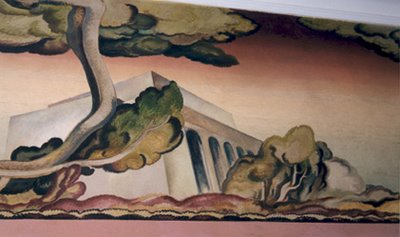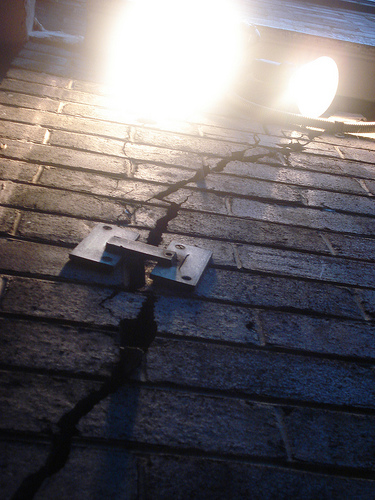
Claremont, CA. Tomato, the main character in Erika Lopez’s terrifically kooky Flaming Iguanas, loves the post office. She says, to be precise, that she has a “profound love for the United States Postal Service.” She laments that too few people seem to share that love:
“I don’t think they truly understand the joy of writing a letter on cool paper, putting it in an envelope, and addressing it in a funky way that challenges postal workers. The stamp validates the whole thing somehow, and whew! – Putting it in the mailbox and hearing that blue metal flap swing shut is just about the prettiest sound in the natural world. / The universal sound of closure. And a canceled stamp is just about the prettiest sight. It’s almost love, and sometimes it really is love. (Unless it’s a val-u-pak of coupons.) It means someone thought of you for more than the fifteen seconds it took to dial your number and leave the message for you to call them back.
Plus mail is such a good deal.
The postal service is amazing and I love everyone who passed that social-service test.”
With post offices about to close across the country, it’s hard not to be swayed by a little postal romance. The post office has been one of the most intractable American institutions: the position of Postmaster General predates the Constitution (and was first held by Benjamin Franklin, in 1775). And the post office’s unofficial motto – “neither snow nor rain nor gloom of night stays these couriers from the swift completion of their appointed rounds” – dates to the beginnings of Western civilization as we know it, to Herodotus’s description of the messenger service in the Persian Empire.
“Than this system of messengers there is nothing of mortal origin that is quicker,” Herodotus wrote. That was 2,500 years ago, give or take.
But that was then, and this is now, and today Herodotus would be wrong. Today e-mail is quicker. Faxing is quicker. Telephone calls are quicker. If the marvels of the postal service historically were once about speed and efficiency, they are so no longer. Written communication through the post is languid and unhurried, comparatively speaking.
If there is a ground which to defend post offices today, it cannot be on those ancient terms. If there is a ground on which to defend post offices today, it has to be apart from or against the value of efficiency.
It is also probably pointless to defend post offices in terms of material necessity. You could argue, I suppose, that post offices should continue to exist because certain material items need to get from one place to another, and neither e-mail nor fax nor speed of telephone can effect that transit. (So, for instance, today I went to the post office to mail a shirt to my best friend. That shirt, tangible as it is, could not be conveyed by e-mail.) Even so, if I were a libertarian – if it is not obvious, for the record, I am not – I would argue that free markets in the absence of a national post would respond to the need for material transit. You could always visit a FedEx store, in other words.
So why care about the post office?
I care about the post office because it remains at least a semi-public common space. When my neighbors worried that the President’s health-care plan was the tip of some kind of socialistic, Nazi-style attempt to take over America, they set up shop outside the town post office. They did so, I assume, because they knew that the post office was a common-denominator place, where they were likely to encounter the broadest swath of local residents. Their strategy to some extent undermined their philosophy: even as they bemoaned public strategies, they relied on the centrality of a space supported by public mandate.
And I care about the fate of the post office as a canary-in-the-coal-mine thing. The closure of 1,000 post offices signals the transition into a world where common social spaces are collapsing as private corporations are expanding, a world in which it’s hard not to hear Edmund Burke whispering about “sophisters, economists, and calculators.”
The post office in Claremont, California, where I live, has a mural all along its ceiling that was painted by Milford Zornes, one of the giants of American watercolor. (He was also, I must say in my partisan way, a Pomona College graduate). The mural was commissioned by the U.S. Treasury Department in 1933, as part of the Treasury Relief Art Project. The project was designed to “give work to artists by arranging to have competent representatives of the profession embellish public buildings.”
Although that project didn’t by itself transform the Depression economy, it gave Zornes some work – he was paid $96 a month – and it also gave Claremont some lasting and evident public beauty. And as so many smart people have written, there is always something more to aesthetic beauty than just the beautiful surface. Beauty is often inspirational, maybe even sublime. Looking at a beautiful thing can make us see, and see consciously, in new ways.
The country in which the public would support an artist like Milford Zornes to paint something for a local community to own, share, and enjoy together seems far away from this one – except when I go to the post office, and I look at that grand mural.
I notice now that in Erika Lopez’s description of the postal service, she focuses so much on the senses, and on what is tangible about mail by post: sound and touch and sight. What I think makes me grit my teeth when I hear about post office closures is the slow decline of a tangible public or community sphere: a public or community that you can see, feel, and hear.
People today keep criticizing the Obama administration because they say they can’t see any changes as a result of the stimulus (except for maybe the now defunct cash-for-clunkers program), and they can’t see what health-care reform might do for them. I keep hearing the way in which these criticisms lie in the language of the senses, in the language of the tangible. There is no tangible evidence that anything is happening differently in daily life. Government seems abstract and impersonal, hard to access and impossible to touch.
Maybe that by itself is a reason, rather than shutting down those very tangible spaces which still have the aura of common service or common purpose, to think about the value of real public spaces, real places for you to plant your feet and gaze around, or even up.











I second this tribute to the U.S. Postal Service, feeling it one of the last true bargains left to us. In my tony little burg of 4-5 villages, word has it that two out of the three post offices might be shuttered, one of them where my P.O. Box resides. Having given up on the personal roadside mailbox long ago during some fever pitch mailbox ransackings that culminated in my heavy duty cast alum. box actually being pulled up post and all and tossed under the bridge of the neighbor a half a mile up the road, I enjoy the ceremony of entering the postal branch and unlocking the contents of my little treasure box. I can’t blame them for closing one or so of our post offices…..seems a bit much to have three offices in a town of barely 4,000.
But, to the point….I rue the day we entered this electronic age that began with the FAX and has ended up in this here tubes of the internets. One used to be able to say they had not received something or that they would reply by return mail but now, everyone must stop what one is doing, obliterate any chain of concentration and deal with the schedule of the caller in a hurry. Business now, with all its electronica is verging on a kind of high tech idiot savantica.
And as to those wonderful murals in Town Halls and Post Offices across the land…….one wonders if the TARP Bailout Banks might open up their Penthouse art collections to the public at a date uncertain or perhaps we might one day see something truly lasting out of this “Cash fer Clunkers” program that un-economically and roundly un-environmentally demo’d perfectly good cars to give money away so people could buy primarily Toyotas.
I third this charming tribute to the U.S. Postal Service, but I’m not sure about it being one of the last true bargains left to us, as the clerk wanted $52 dollars, Priority Mail, to send a large box containing two Waldorf dolls, for my granddaughters, from my non-tony town in Texas, to Leesburg Virginia. I opted for the snail mail rate which took 10 days to travel the distance, but the girls LOVE them and I saved $25. The best bargain is I only had to travel 6 blocks to my post office, which is across the street from the bank and catty corner from the Episcopal school where I teach art to yungins, including philatelical art. The art of making envelopes might come in handy if the Congress gives the President a “kill switch” on the Internet that would allow him to shut out private networks from online.
Milford Zornes also made a mural for the El Campo, Texas, U.S. Post Office,
“Rural Texas Gulf Coast”. The detail images are
wonderful.
El Campo, (70) miles southwest of Houston, population 10,945, has more murals than any other city in Texas. The community project of adding historical murals painted from old photographs on the sides of buildings gives their children a sense of place.
I wonder if the PO has efficiencied itself into inefficiency.
Consider: The US population has doubled since 1950.
In 1950 the Post Office was able to deliver twice a day
without any strain, and within a city gave same-day
service.
Twice the population * half the deliveries = same total.
Why can’t they keep up today? Could it be because they
stopped thinking? It makes no sense to rely on a 9-digit
ZIP code when the address itself is also present. Blind
reliance on mass production and technology leads to
wild inefficiency.
How will one send or receive packages from overseas without the post office? Within the past few days I have sent a book about St. Mixomos to a friend in Australia and my youngest daughter received a vintage Everyman’s Library edition of Dickens’s Our Mutual Friend from a bookseller in England. The book cost him over five pounds to ship, but the cost of the book & shipping, for me (it was a gift), was under $12. I don’t think Fed Ex et al. are on board with such deals.
Aside from such concerns, I also want to say something nostalgic about the importance of the post office in the world of science fiction and fantasy fandom (and the earlier “amateur journalism”). There’s been a love-hate attitude towards the post office on the part of fanzine producers and readers from the beginning, based on the longing for new issues to show up in today’s mail, and on the exasperation provoked by the delivery of busted-open envelopes from which precious hectographed, mimeographed, or dittoed ‘zines have been lost or in which they have been damaged. Who of us hasn’t written messages on such envelopes: “Postal Goons Have Mercy!” or the like?
Ah, tales of bad experiences with the mail system have served as common coin of small talk among fans, who, however, all know too the excitement of sending and receiving fannish stuff. Envelope decorations? Of course. I used to get envelopes from a Secret Agent/Prisoner fan that had Patrick McGoohan stamps and stickers reading “Anticipate the Village” on them. I’m sure that, if you’re a young kid who writes to an author’s website and the author posts a response, you feel good; but what can compare to my experience, back in the Seventies, of seeing a pro author’s address in a fanzine, writing to him, and getting a signed letter in response? L. Sprague de Camp, Poul Anderson, Lin Carter — thank you again, men; you made my day. Even Big Name authors to whom one wrote c/o their publishers might respond with a letter: I have letters from Richard “Watership Down” Adams. I don’t know if that sort of thing happens any more, but what a treat it was back in the day.
Recently I revisited my hometown of Ashland, Oregon, and had to stand in line for half an hour to mail a couple of packages. A bit tiresome, and yet it gave me time to reflect on many an earlier visit to the same counter, with an envelope of apazines to mail off to the central mailer… Kids these days, they don’t know what they’ve missed.
Er, Maximos. Miximos was censured by the Council of Edriophtalma in 943.
The PO in our town got consolidated with the one in the next town over well prior to the release of the big list o’ closures. That left the 110 households in town with no home delivery scratching our heads and wondering whether to put up a mailbox or to accept the offer of a PO box too far away to walk to regularly at a post office with virtually no parking. Just about everyone elected for putting up a mailbox. But we weren’t allowed to put up the little wall-mounted boxes to be visited by a mailman on foot. Nope, we were required to put in a post and a box on the street at a location specified by a little white flag which showed up out of thin air sometime between Tuesday and Wednesday.
As you mention, the PO in our town was a public space, although space is perhaps too generous a word. (One of the reasons put forward for closing the office was that the lack of space was a safety issue.) The office was across the hall from the borough offices in the building that used to house the local school. So, there was the town bulletin board, the place where we all paid our water and sewer bills, the upstairs room where borough council had their regular meetings, and the post office, all jammed together in one place. As everyone made daily trips to get the mail, we all saw one another a good bit. And as the poor sucker on the receiving end of an invalid debt collection lawsuit, the post office was a necessary origin point for the sending of lawyerly-sounding certified letters to the hellhounds who pursued me. The postal scales was used more than once to assess the weight of a pine wood derby car under construction to make sure it would meet the race entry criteria just so, we having no scale accurate enough for the purpose in our possession.
So now we have home delivery, and a mailing address that matches the street address (you wouldn’t believe how many absurd problems that caused when attempting to mail order something that was delivered by someone other than the USPS). It’s convenient, sure, but now I only have need to hit the borough building once a month. The FBI’s Most Wanted list is gone from the wall, replaced by agitprop from some local hysterian who thinks the borough council consists of Illuminati conspirators, and no one takes it down because no one passes by. The town bulletin board has that woeful unmaintained look, with announcements attaining a yellowed brittleness and being posted far in excess of their relevancy. Again, few people go by it anymore, so why bother? A lost cat I know to have been found (dead) is still listed as lost and please tear off a tag with my phone number and call me if you see him. Its rather pathetic, really. Something has been lost, and whatever it was we gained, I’m not sure it even comes close to compensating.
I would like to say that this post really forced me to do so! I found your blog on google and read a few of your other posts. I just added you to my Google News Reader. Keep up the good work. Look forward to reading more from you in the future.
Comments are closed.